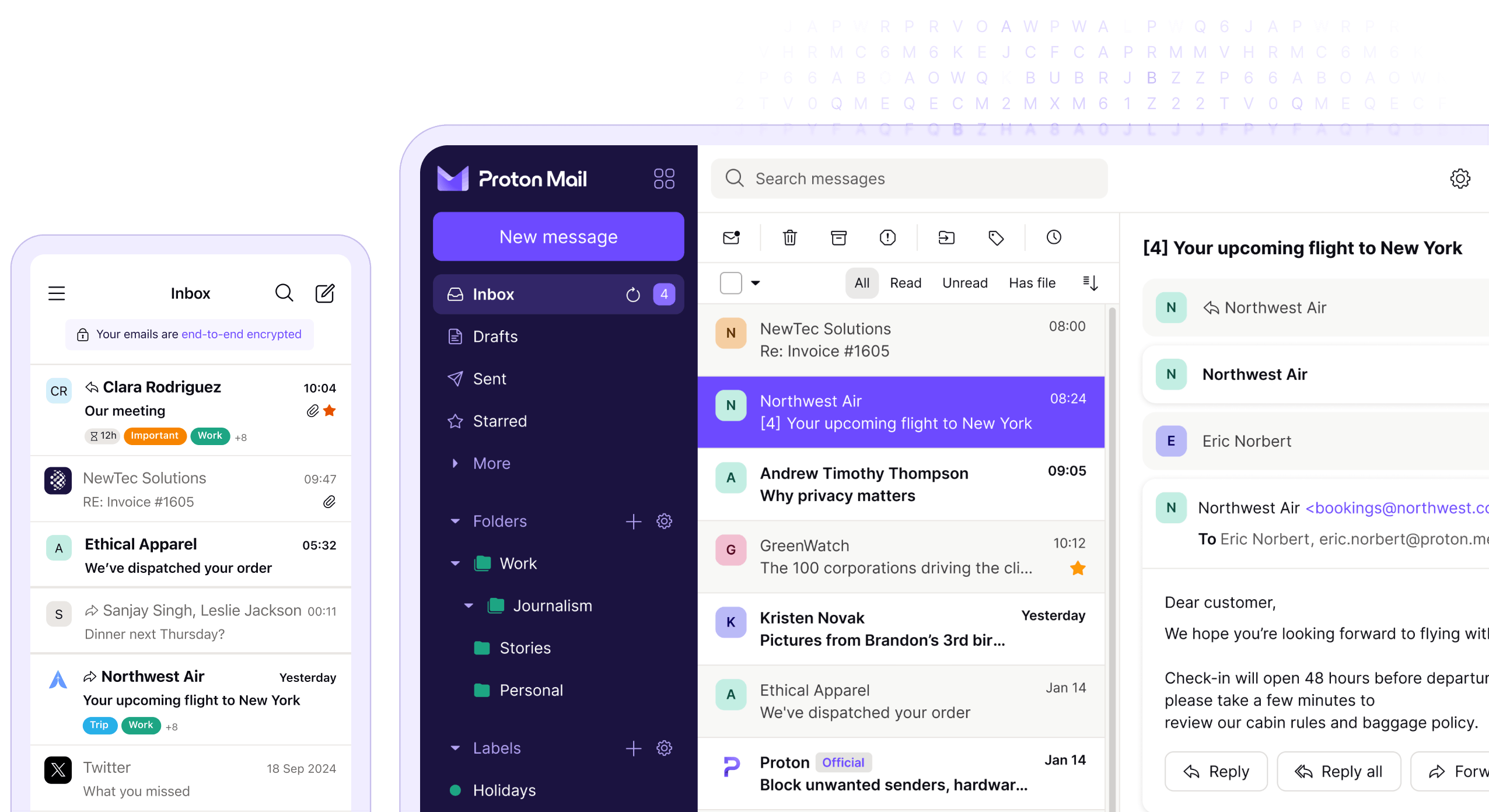Support für Proton Mail
Hier findest du Antwort auf deine Fragen zu Proton Mail. Wie können wir dir helfen?

Kategorien in Proton Mail
Wir können dich bei jedem Schritt der Verwendung von Proton Mail unterstützen, vom Einrichten deines Kontos bis zum Senden deiner ersten E-Mail.
Häufig gestellte Fragen
Die Sicherheit unserer Nutzer ist eines unserer wichtigsten Anliegen. So machen wir Proton Mail sicher:
- Und so machen wir Proton Mail sicher: Ende-zu-Ende-Verschlüsselung: Nachrichten zwischen Proton Mail-Nutzern werden in einem verschlüsselten Format auf unseren sicheren Servern übermittelt und gespeichert. Da deine Daten bei jedem Schritt verschlüsselt sind, ist das Risiko abgefangener Nachrichten so gut wie ausgeschlossen.
- Kein Zugriff auf deine Daten: Nur du hast den Schlüssel zum Entschlüsseln deiner Nachrichten und Dateien, die auf unseren sicheren Servern gespeichert sind Niemand sonst hat Zugang zu deinen Daten – nicht einmal wir. Da wir keinen Schlüssel für den Zugriff auf deine Daten haben, können wir sie auch nicht an Dritte weitergeben.
- Passwortgeschützte E-Mails: Nachrichten zwischen Proton Mail-Nutzern werden automatisch Ende-zu-Ende-verschlüsselt Du kannst mithilfe von passwortgeschützten E-Mails oder standardmäßiger PGP-Verschlüsselung aber auch an Menschen bei anderen E-Mail-Anbietern Ende-zu-Ende-verschlüsselte Nachrichten schicken.
- Quelloffen: Unsere Apps sind alle quelloffen und unabhängig geprüft, damit jeder unseren Code überprüfen kann.
- Starke physische Sicherheit: Wir haben stark in Eigentum und Kontrolle unserer eigenen Server-Hardware investiert Unsere Rechenzentren befinden sich an hochsicheren Standorten, die biometrischen Zugang erfordern.
Wir haben Proton Mail entwickelt, um verschlüsselte E-Mail für alle auf der ganzen Welt einfach verfügbar zu machen. Wir sind uns bewusst, dass manche Menschen, die unsere Dienste am dringendsten benötigen, nicht dafür bezahlen können. Daher bieten wir Proton Mail Free an – unser kostenloses E-Mail-Abonnement, das dieselbe Sicherheitsstufe und Benutzerfreundlichkeit bietet wie unsere kostenpflichtigen Abonnements.
Wenn du mehr Speicher, unbegrenzte Ordner, Kategorien und benutzerdefinierte Filter, benutzerdefinierte E-Mail-Domains und mehr benötigst, denk über ein Upgrade auf ein kostenpflichtiges Abonnement nach. Du bekommst nicht nur erweiterte Funktionen. Du unterstützt uns auch bei unseren Bemühungen, Online-Privatsphäre und Sicherheit für alle zugänglich zu machen.
Verschlüsselung ist ein Prozess zur Umwandlung von Nachrichten oder Informationen auf eine solche Weise, dass nur berechtigte Parteien sie lesen können. Mithilfe komplexer Algorithmen wird eine Nachricht in eine unleserliche Zeichenfolge umgewandelt. Der einzige Weg, um die Nachricht in ihr ursprüngliches Format zu verwandeln, ist die Verwendung eines einzigartigen Verschlüsselungsschlüssels.
Wenn du einem anderen Benutzer von Proton Mail eine E-Mail sendest, oder wenn du eine Nachricht von einem anderen Benutzer von Proton Mail erhältst, werden der Nachrichtentext und die Anhänge in jedem Schritt automatisch verschlüsselt. Das wird als Ende-zu-Ende-Verschlüsselung bezeichnet.
Alle Nachrichten und Anhänge, die du im Postfach von Proton Mail empfängst, werden ebenfalls mit Zero-Access-Verschlüsselung gespeichert, einschließlich Nachrichten von anderen E-Mail-Anbietern Nur du hast den Schlüssel für den Zugriff auf deine Nachrichten und Daten auf unseren sicheren Servern. Das bedeutet, dass niemand sonst Zugang zu deinen Daten hat – nicht einmal wir.
Du kannst Ende-zu-Ende-verschlüsselte Nachrichten mithilfe von passwortgeschützten E-Mails auch an Personen mit anderen E-Mail-Anbietern senden.
Ansonsten werden sie mit TLS-Verschlüsselung geschützt, sofern der Server außerhalb von Proton Mail dies unterstützt.
Proton verfügt über vier unterschiedliche E-Mail-Domains, die du zum Erstellen von E-Mail-Adressen verwenden kannst:
- @proton.me ist die Standard-Domain für Proton Mail. Wenn du dich registrierst, wirst du aufgefordert, eine @proton.me-Adresse (deinbenutzername@proton.me) zu erstellen.
- @protonmail.com ist eine alternative Domain, die du auswählen kannst, wenn du dich registrierst, oder zum Erstellen von zusätzlichen Adressen verwenden kannst (deinbenutzername@protonmail.com).
- @pm.me ist unsere Kurzdomain. Du kannst deine kurze E-Mail-Adresse aktivieren (deinbenutzername@pm.me), nachdem du dich registriert hast, sofern dein Benutzername verfügbar ist.
- @protonmail.ch ist unsere ursprüngliche Proton Mail-Domain. Wenn du vor 2016 zu Proton gestoßen bist, verfügst du über eine zusätzliche kostenlose @protonmail.ch-Adresse (deinbenutzername@protonmail.ch).
Um deine @proton.me-Adresse zu aktivieren, melde dich bei deinem Konto an (account.proton.me) und klicke auf Einstellungen → Zu den Einstellungen → Identität und E-Mail-Adressen.
Wenn du ein kostenpflichtiges Proton-Abonnement hast, kannst du zusätzliche E-Mail-Adressen (Alias-Adressen) bei den oben aufgeführten Proton-Domains oder deiner eigenen Domain (@deinedomain.de) erstellen.
Erfahre mehr über die verschiedenen Arten von Adressen und Alias-Adressen
Du kannst auch eine beliebige Adresse als deine Standard-Absenderadresse festlegen.
Proton Mail Bridge ist eine App für Windows, macOS und Linux. Sie ermöglicht es dir, dein Proton-Mail-Konto mit E-Mail-Clients von Drittanbietern zu verwenden, darunter Outlook, Thunderbird und Apple Mail, und dabei deine E-Mails sicher zu halten, indem du die Ende-zu-Ende-Verschlüsselung von Proton Mail verwendest.
Proton Mail Bridge ist für alle zahlenden Abonnenten verfügbar. Um das Tool zu verwenden, installiere die Proton Mail Bridge-App, und konfiguriere dann deinen bevorzugten E-Mail-Client dafür.
Wenn du ein kostenpflichtiges Proton Mail-Abonnement hast, kannst du eine benutzerdefinierte Domain zum Senden und Empfangen von E-Mails verwenden (z. B. mit der E-Mail-Adresse yourname@yourdomain.com). Die Anzahl der benutzerdefinierten Domains, die du verwenden kannst, hängt von deinem Proton Mail-Abonnement ab.
Du kannst benutzerdefinierte Domains von Drittanbieter-Registraren wie GoDaddy, Cloudflare oder Namecheap erwerben. So verwendest du eine benutzerdefinierte Domain mit deinem Proton Mail-Konto:
- 1. Füge deine Domain zu deinem Proton Mail-Konto hinzu
- 2. Verifiziere deine Domain, damit Proton weiß, dass es wirklich deine ist
- 3. Konfiguriere die DNS-Einträge deines Domain-Registrars so, dass Proton Mail die über diese Domain gesendeten und empfangenen E-Mails verarbeitet
Zusätzliche Schritte sind erforderlich, wenn du ein Proton for Business-Abonnement hast und Benutzer zu deiner Organisation hinzufügen möchtest, damit sie deine benutzerdefinierte Domain verwenden können.